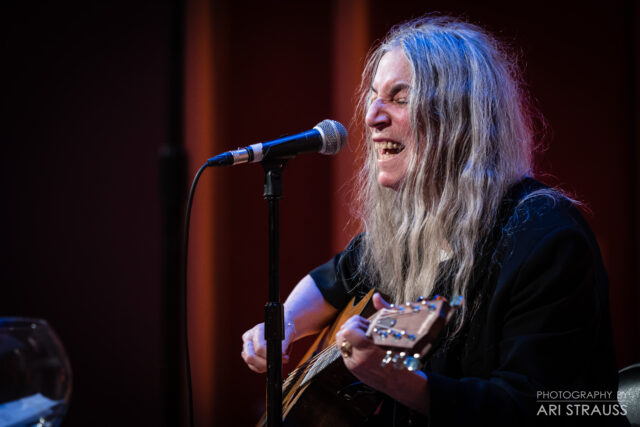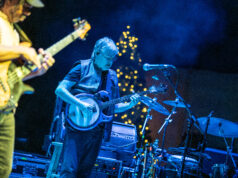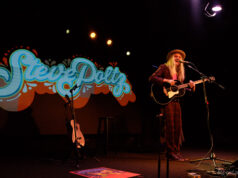Patti Smith performs at Sixth & I Historic Synagogue on Nov. 17, 2022. (Photo by Ari Strauss)
At the Sixth & I Historic Synagogue recently, I learned I have a few things in common with Rock & Roll Hall of Fame inductee Patti Smith. “The Poet Laureate of Punk” and I both brush our teeth with baking soda; Smith offhandedly name it as one of her “best products” and evangelized about its many uses.
Patti Smith spoke at Sixth & I on Nov. 17 in support a new book of photos, titled Book of Days. When she answered a question about whether she gets performance anxiety,I learned we have something else in common. (Questions were submitted in advance; the synagogue was completely packed, and audience participation wouldn’t have been practical.) Patti doesn’t get really get performance anxiety, because, as she explained, “I don’t have any expectations of greatness.” While she’s comfortable on stage in front of an audience, she finds socializing more difficult, and she’s bad at small talk. In her National Book Award-winning memoir, Just Kids, which recounts her long relationship with the late, controversial photographer Robert Mapplethore, she mentions being rough around the edges and finding it challenging to fit in to social situations that call for a certain amount of grace.
Smith is a versatile artist; she is both an accomplished writer and photographer in addition to being a first-rate singer and songwriter. She became a published writer before she released her debut album, Horses, in 1975, releasing three chapbooks of her poetry (Seventh Heaven, Early Morning Dream, and A Useless Death) in 1972, with Witt coming out the following year. She told the audience, “Everything I do is rooted in poetry.” She also coauthored a play with Sam Shepard (who was also her partner for a time), Cowboy Mouth, in 1971.
Buy Book of Days, Patti Smith’s new photo book, on Amazon.
Smith found herself especially isolated during the height of the pandemic, kept inside on doctor’s advice because of a “bronchular [sic] condition.” Just before things shut down, she played two shows at The Fillmore in San Francisco, then went into isolation. “Working on this book,” she said, “gave me that imagined connection” with people and the outside world.
Shepard figured prominently in the slideshow, about which Patti asked, “Is this PowerPoint?” She declared herself something of a luddite, having only switched to using a cell phone for photography when the film for beloved Polaroid camera was discontinued. One image showed Shepard’s Stetson hat, while another showed the man himself. In his last few years, Patti explained, he battled ALS, also known as Lou Gehrig’s disease, after the resilient Depression-era New York Yankees player. A book by the French writer Samuel Beckett, who Shepard dearly loved, appeared in the background.
Each page of Book of Days displays a single photo; there are 366, including a photo for February 29, Leap Day. Smith told the audience that, while it’s often forgotten about, “a lot of people are born” on Feb. 29. (I think it would kind of suck to be born on Feb. 29 and to only have a birthday every four years?) Book of Days was inspired by a book from her youth, Around The World in 100 Pictures. As she described in her memoirs, her family was decidedly working-class, and they didn’t have much, but literature and art were valued, inspiring her life-long love for them.
Watch the official music video for “People Have the Power” by Patti Smith on YouTube:
Patti responded to a question about “the most transformational advice” she’s received with a story about the writer William Burroughs. She met Burroughs in the early-mid ’70s, when she was living at the Chelsea Hotel in New York City. (Smith would make the City her home until 1979, when she moved to Detroit with her husband, Fred “Sonic” Smith, formerly a member of the proto-punk band MC5. After his death, she moved back in the mid-’90s.) Burroughs told her, “Whatever in life you do, don’t compromise, don’t do something you’ll regret.” Following that advice, Smith has charted a path that prioritizes good work over fame and fortune, though she’s certainly achieved her share of the latter.
The Chelsea Hotel came up in another question, which asked whether it attracted great people or inspired them. Smith didn’t directly answer this question, instead seeming to sink into nearly half-century old memories, waxing about sharing an elevator with Muhammad Ali and encountering poet Allen Ginsberg, painter Salvador Dali, French filmmaker Jean-Luc Godard, and photographer Diane Arbus.
Asked about a regret, Patti replied she wished she’d spent more time with her mother. She described herself as “always agitated and restless,” and said, “I wouldn’t just sit with her.” Our parents, she said, “know things about us we don’t know about ourselves and our heritage.” One of the photos displayed showed Smith with her mother in Central Park in 1976; it was taken by Lynn Goldsmith.
A related question asked what she would tell her 15-year-old self. “Take care better of your teeth,” she said, noting how bad her generation’s (she was born at the beginning of the Baby Boom) teeth are. (Flouride was only added drinking water during her childhood or adolescence.)
Patti bemoaned the state of her belongings. Asked, “How do you store your personal archives?” she replied, concisely, “Very badly.” She tends to have piles sitting around her home, but some things, especially those that are more important or valuable things, are store in dedicated flat files. She quipped that she “thought when I got older, I’d be like Ava Gardner.”
The slideshow focused notably on accomplished women in science, including an Iranian mathematician, Maryam Mirzakhani , who taught at Stanford and who won the Fields Prize. Sadly, she passed away from breast cancer at the age of 40 in 2017. Smith also gave the spotlight to a female scientist whose work on leprosy wasn’t properly credited to her after a male researcher largely stole her work after her passing.
Smith’s long-time guitarist, Lenny Kaye, came on stage after the slideshow, and they played few songs, beginning with “Grateful.” The next, “My Blakean Years,” was inspired by British mystical poet William Blake’s dying in poverty. Between songs, she told a joke from Lewis Carroll, “Why is a raven like a writing desk?” She never gave the answer to the Mad Hatter’s question; you’ll have to find it in either Through The Looking Glass or Alice In Wonderland. (Childrens literature came up earlier, when she declared there is “hardly a book that beats Pinocchio; she displayed a photo of a Pinocchio doll. The book, she said, “has everything.”) She also spoke of her cat, Cairo, the runt of the litter she adopted, who is now north of 20 years old.
Watch Patti Smith perform “Grateful” live for MyMusicRx on YouTube:
Going back to songs, she and Lenny played “Ghost Dance,” which they wrote together in 1978, in honor of the Hopi tribe. She ended the evening by expressing her desire to see the District of Columbia granted Congressional repression, and they played “People Have The Power.”
The event lasted about an hour and forty-five minutes, but it started at 7pm, so we were out before 9pm, which I can appreciate now that I’m in my 40s. Smith was a delight, an engaging speaker and powerful singer, and this was an event not to be forgotten.






